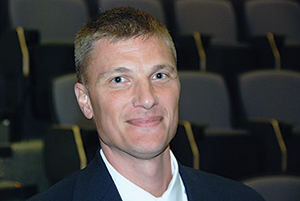Fear Extinction Requires Multipronged Intervention
Abstract
Extinction of conditioned fear in both civilian and military populations requires genetic, neuroendocrine, and psychophysiological components.
A pile of trash burning in a field off an interstate highway in Georgia might seem unremarkable, but to a veteran traumatized by a roadside bomb blast, it’s another stimulus that brings back the fear he felt in Iraq, said Seth Norrholm, Ph.D., at the Eighth Annual Conference on the Amygdala, Stress, and PTSD, held April 23 at the Uniformed Services University of the Health Sciences in Bethesda, Md.

An overload of fear can inhibit or delay fear extinction in patients with PTSD, said Emory University’s Seth Norrholm, Ph.D.
Norrholm, an assistant professor of psychiatry and behavioral sciences at Emory University School of Medicine, uses classical Pavlovian fear conditioning paradigms to study the physiological, neuroendocrine, and genetic factors that influence fear acquisition and extinction in both rodents and humans.
To model these symptoms, he focuses on fear-potentiated startle, the exaggerated startle reaction to a stimulus that occurs when the subject (whether animal or human) is afraid.
The model can also serve as a way of observing the effects of exposure-based extinction on how training reduces or eliminates the conditioned fear response.
Norrholm, Kerry Ressler, Ph.D., and colleagues at Emory have been studying a cohort of more than 6,000 civilians who have been treated at Atlanta’s Grady Memorial Hospital. Most of them are low-income African Americans who have experienced severe trauma. The researchers have accumulated startle data on a subsample of 500 of those patients, comparing the patients with and without posttraumatic stress disorder (PTSD).
Traumatized individuals with PTSD showed more fear-potentiated startle in fear-acquisition training.
“There was no difference in cognitive awareness of fear and safety cues, but there was a difference at the level of the amygdala in fear acquisition,” he said. In the extinction phase, those with PTSD again had a much greater fear-potentiated startle than those without the disorder.
Norrholm calls this difference “fear load,” a term that represents the much greater level of fear at the beginning of the extinction phase, which must be overcome in order to extinguish the fear-potentiated startle. It is the deficit the patient has to make up before achieving extinction.
“Civilian PTSD patients show greater fear load at the time of extinction,” said Norrholm.
He also found that among combat veterans of conflicts beginning with the Vietnam War, individuals with high re-experiencing symptoms had a higher fear load but were still able to extinguish fear.
He divided a cohort of 168 veterans of the wars in Iraq and Afghanistan into those with high and low levels of PTSD symptoms. He found no difference in the acquisition of fear-potentiated startle. However, those with less-severe symptoms had a clear reduction in fear-potentiated startle, while those with higher symptom levels showed no reduction, indicating impairment.
“Veteran PTSD patients displayed impaired within-session extinction of fear, an effect that is strongly associated with PTSD symptom severity,” he said.
Epigenetic mechanisms also come into play in Norrholm’s research. DNA methylation silences genes, reducing protein expression and leading to behavioral effects. With the well-studied COMT gene, for example, the met/met allele renders individuals more susceptible to anxiety disorders, he said.
“But the genotype alone is not significant, it’s the gene-by-environment interaction,” he said. The presence of the met/met allele in PTSD patients increases their fear load.
His group also analyzed blood levels of the ADCYAP1 gene, which encodes the pituitary adenylate cyclase-activating polypeptide (PACAP) protein. In women with PTSD, but not in men, higher levels of the PACAP predict fear-potentiated startle response.
Finally, pilot data from neuroendocrine studies of traumatized women indicate a role for estrogen as well. Women with PTSD and low estrogen levels appear to have lower levels of fear-potentiated startle than those with high estrogen levels.
There may be initial clinical implications of Norrholm’s research, even at this early stage. “Fear-loaded patients may require a greater degree of intervention to overcome initial elevated levels of fear,” he said. ■
More information on Seth Norrholm’s research is posted at http://www.frontiersin.org/Behavioral_Neuroscience/10.3389/fnbeh.2013.00030/abstract.



